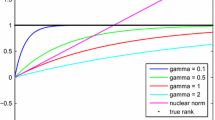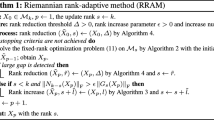Abstract
The rank function rank(.) is neither continuous nor convex which brings much difficulty to the solution of rank minimization problems. In this paper, we provide a unified framework to construct the approximation functions of rank(.), and study their favorable properties. Particularly, with two families of approximation functions, we propose a convex relaxation method for the rank minimization problems with positive semidefinite cone constraints, and illustrate its application by computing the nearest low-rank correlation matrix. Numerical results indicate that this convex relaxation method is comparable with the sequential semismooth Newton method (Li and Qi in SIAM J Optim 21:1641–1666, 2011) and the majorized penalty approach (Gao and Sun, 2010) in terms of the quality of solutions.
Similar content being viewed by others
References
Bhatia R.: Matrix Analysis. Springer, New York (1997)
Boyd S., Xiao L.: Least-squares covariance matrix adjustment. SIAM J. Matrix Anal. Appl. 27, 532–546 (2005)
Brigo, D.: A note on correlation and rank reduction. http://www.damianobrigo.it (2002)
Burer S., Monteiro R.D.C., Zhang Y.: Maximum stable set formulations and heuristics based on continuous optimization. Math. Program. 94, 137–166 (2002)
Candès E.J., Recht B.: Exact matrix completion via convex optimization. Found. Comput. Math. 9, 717–772 (2009)
Cai J.F., Candès E.J., Shen Z.: A singular value thresholding algorithm for matrix completion. SIAM J. Optim. 20, 1956–1982 (2010)
Chao, D., Sun, D.F., Toh K.-C.: An introduction to a class of matrix cone programming. Technical report, http://www.math.nus.edu.sg/ (2010)
Chen C., Mangasarian O.L.: A class of smoothing functions for nonlinear and mixed complementarity problems. Comput. Optim. Appl. 5, 97–138 (1996)
Clarke, F.H.: Optimization and Nonsmooth Analysis. Wiley, New York (1983) (reprinted by SIAM, Philadelphia, PA, 1990)
Eldén L.: Matrix Methods in Data Mining and Pattern Recognition (Fundamentals of Algorithms). SIAM, Philadelphia, PA, USA (2007)
Fazel, M.: Matrix rank minimization with applications. PhD thesis, Stanford University (2002)
Fazel, M., Hindi, H.,Boyd, S.: Log-det Heuirstic for Matrix Rank Minimization with Applicatios to Hankel and Euclidean Distance Matrices. ACC03-IEEE06884 (2003)
Fazel, M., Hindi, H., Boyd, S.: Rank minimization and applications in system theory. In: Proceeding of the American Control Conference, vol. 4, pp. 3273–3278 (2004)
Gao, Y., Sun, D.F.: A majorized penalty approach for calibrating rank constrained correlation matrix problems. Technical report (2010)
Goemans, M.X., Williamson, D.P.: 0.878-approximation algorithms for MAX CUT and MAX 2SAT. Lecture Notes Computer Science, pp. 422–431 (1994)
Grubiŝić I., Pietersz R.: Efficient rank reduction of correlation matrices. Linear Algebra Appl. 422, 629–653 (2007)
Hestenes M.R., Stiefel E.: Methods of conjugate gradients for solving linear systems. J. Res. Natl. Bureau Stand. 49, 409–436 (1952)
Higham N.J.: Computing the nearest correlation matrix-a problem from finance. IMA J. Numer. Anal. 22, 329–343 (2002)
Hiriart-Urruty J.B., Lemaréchal C.: Convex Analysis and Minimization Algorithm I. Springer, Berlin Heidelberg (1993)
Lewis A.S.: Derivatives of spectral functions. Math. Oper. Res. 21, 576–588 (1996)
Lewis A.S.: The convex analysis of unitarily invariant matrix functions. J. Convex Anal. 2, 173–183 (1995)
Li Q.N., Qi H.D.: A sequential semismooth Newton method for the nearest low-rank correlation matrix problem. SIAM J. Optim. 21, 1641–1666 (2011)
Linial N., London E., Rabinovich Y.: The geometry of graphs and some of its algorithmic applications. Combinatorica 15, 215–245 (1995)
Liu Z., Vandenberghe L.: Interior-point method for nuclear norm approximation with application to system identification. SIAM J. Matrix Anal. Appl. 31, 1235–1256 (2009)
Liu Y.-J., Sun D.F., Toh K.C.: An implementable proximal point algorithmic framework for nuclear norm minimization. Math. Program. 133, 399–436 (2012)
Ma S., Goldfarb D., Chen L.: Fixed point and Bregman iterative methods for matrix rank minimization. Math. Program. 128, 321–353 (2011)
Malick J.: A dual approach to semidefinite least-squares problems. SIAM J. Matrix Anal. Appl. 26, 272–284 (2004)
Mesbahi M.: On the rank minimization problem and its control applications. Syst. Control Lett. 33, 31–36 (1998)
Morita M., Kanade T.: A sequential factorization method for recovering shape and motion from image streams. IEEE Trans. Pattern Anal. Mach. Intell. 19, 858–867 (1997)
Natsoulis G., Pearson C.I., Gollub J., Eynon B.P., Ferng J., Nair R., Idury R., Lee M.D., Fielden M.R., Brennan R.J., Roter A.H., Jarnagin K.: The liver pharmacological and xenobiotic gene response repertoire. Mol. Syst. Biol. 4, 1–12 (2008)
Pietersz R., Grubiŝić I.: Rank reduction of correlation matrices by majorization. Quant. Financ. 4, 649–662 (2004)
Qi H.D., Sun D.F.: A quadratically convergent Newton method for computing the nearest correlation matrix. SIAM J. Matrix Anal. Appl. 28, 360–385 (2006)
Rebonato R.: Modern Princing and Interest-Rate Derivatives. Princeton University Press, New Jersey (2002)
Rebonato R.: Interest-rate term-structure pricing models: a review. Proc. R. Soc. Lond. Ser. A 460, 667–728 (2004)
Recht B., Fazel M., Parrilo P.: Guaranteed minimum rank solutions of matrix equations via nuclear norm minimization. SIAM Rev. 52, 471–501 (2010)
Rennie, J.D.M., Srebro, N.: Fast maximum margin matrix factorization for collaborative prediction. In: Proceeding of the 22nd International Conference on Machine, pp. 713–719 (2005)
Sun D.F., Sun J.: Semismooth matrix valued functions. Math. Oper. Res. 27, 150–169 (2002)
Sun D.F.: The strong second-order sufficient condition and constraint nondegeneracy in nonlinear semidefinite programming and their implications. Math. Oper. Res. 31, 761–776 (2006)
Sun D.F., Sun J: Strong semismoothness of eigenvalues of symmetric matrices and its application to inverse eigenvalue problems. SIAM J. Numer. Anal. 40, 2352–2367 (2003)
Toh K.C.: An inexact path-following algorithm for convex quadratic SDP. Math. Program. 112, 221–254 (2008)
Toh K.C., Yun S.W.: An accelerated proximal gradient algorithm for nuclear norm regularized linear squares problems. Pac. J. Optim. 6, 615–640 (2010)
Tomasi C., Kanade T: Shape and motion from image streams under orthography: a factorization method. Int. J. Comput. Vis. 9, 137–154 (1992)
Wu L.: Fast at-the-money calibration of the LIBOR market model using Lagrangian multipliers. J. Comput. Financ. 6, 39–77 (2003)
Zhang Z., Wu L.: Optimal low-rank approximation to a correlation matrix. Linear Algebra Appl. 364, 161–187 (2003)
Zhao Y.B.: Approximation theory of matrix rank minimization and its application to quadratic equations. Linear Algebra Appl. 437, 77–93 (2012)
Author information
Authors and Affiliations
Corresponding author
Additional information
This work was supported by National Young Natural Science Foundation (No. 10901058) and the Fundamental Research Funds for the Central Universities, and Project of Liaoning Innovative Research Team in University (WT2010004).
Rights and permissions
About this article
Cite this article
Bi, S., Han, L. & Pan, S. Approximation of rank function and its application to the nearest low-rank correlation matrix. J Glob Optim 57, 1113–1137 (2013). https://doi.org/10.1007/s10898-012-0007-0
Received:
Accepted:
Published:
Issue Date:
DOI: https://doi.org/10.1007/s10898-012-0007-0




